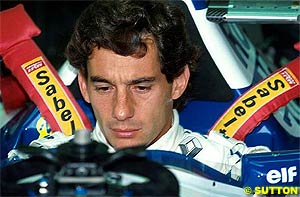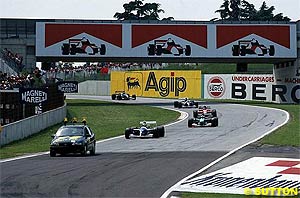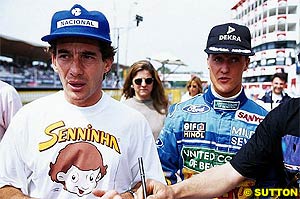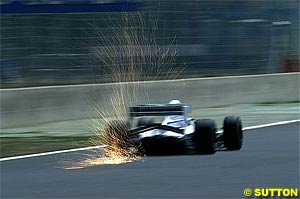
Atlas F1 Senior Writer
Karl Ludvigsen examines how the world of F1 responded to the tragic weekend of the 1994 San Marino GP with powerful new initiatives to improve safety and survivability
The involvement of FOCA-backed Watkins, who had excellent contacts in the motor-racing world, helped raise the standards of facilities and experts at all the major tracks. The importance of having runoff areas and tyre barriers instead of Armco at key points along the circuits was becoming understood and implemented.
In 1982, however, attention began to turn to the car as well. When Gilles Villeneuve crashed fatally at Zolder and was hurled from his Ferrari, his seat and belts were torn from the monocoque. In contrast to the early years of the sport, survival now is always more likely if the driver stays with the car. This is especially the case with today's rugged carbon-fibre monocoques.
The importance of trying to protect a driver's feet and legs was increasingly recognized. In 1985, for the first time, the noses of monocoques were subjected to static impact tests. That same year saw a 25-year-old Brazilian, Ayrton Senna, move from the Toleman team to Renault-powered Lotus. There his teammate was the patrician Italian Elio de Angelis, whom he found so congenial that they went on holidays together. In 1986 de Angelis moved to Brabham. While testing his BT55-BMW at Paul Ricard in May 1986 he crashed heavily, the car overturning and catching fire. He did not survive.
The death of one of the few of his peers that the competitive Senna had befriended was certainly a blow to the Brazilian. "Once you sit in a racing car you know you are taking risks," he said. "We never think we are going to have an accident or get hurt, but it is always at the back of the mind. It is that knowledge that determines the limit you establish for yourself. It is very important because it helps you to stay together and not go beyond your limit. You can be guided by self-preservation without losing your commitment."
"I cannot understand how Farina didn't die earlier," said Juan Manuel Fangio of Farina. "When I followed him in the Alfa Romeo it was incredible; he drove like a madman. We used to say that he was protected by the Madonna, but even the Holy Madonna's patience has a limit and he should have considered that she could not be at his disposal all the time." Much the same could have been said of Senna.
The season in which Senna was killed saw several important changes to the cars and racing. Refueling, banned since 1984, was again permitted, largely for the sake of added spectacle. Cars were stripped of many aids such as launch control, traction control, ABS, power brakes, fly-by-wire throttles and active suspension. Because of these omissions, forecast Ayrton Senna, "It's going to be a season with lots of accidents, and I'll risk saying we'll be lucky if something really serious doesn't happen. It was a great error to remove the electronics in the cars. The cars are very fast and difficult to drive." This was especially true of the Williams FW16-Renault. The team itself admitted that after two years with active suspension it was struggling to get to grips again with ordinary springs and dampers.
Crashes in practice at Imola caused Senna furiously to think. The death of Roland Ratzenberger on Saturday was a great shock; Senna broke the track's rules by commandeering a course car to visit the crash site. No less alarming was the lurid crash on Friday of Senna's friend and protege Rubens Barrichello, who was lucky to suffer no more than a concussion and broken nose after being lifted unconscious from his shattered Jordan. Ayrton visited Rubens in the track's medical centre before setting his pole-position qualifying time.
Following practice Niki Lauda, no stranger to racing crashes, approached Senna about reviving the Grand Prix Drivers Association that he'd led until his retirement in 1985, after which it had been moribund. Lauda felt that a revived GPDA would help the drivers defend their corner more effectively at a time when the risk of mortal accidents seemed to be on the rise. "They see accidents happen but nobody getting hurt," said Lauda of his fellow racers, "and they stop thinking about what is really at risk. If we start believing that motor racing is not dangerous, then we are all stupid."
Before that, on the Friday, Michael Schumacher had indeed fulfilled Senna's commitment by bringing the drivers together to relaunch the GPDA. "I would like to push to get as much done as possible," said the German, who would dedicate his 1994 World Championship to Senna. Wendlinger's crash only served to underline the urgency of the task.
In the immediate aftermath, ideas popped up left, right and center. The timing of pitstops, said Max Mosley, would be determined by the drawing of lots before the race. He added that every pitlane would be squeezed at both ends by tight chicanes. Airbags could be fitted, he said, and measures would be taken to slow the cars.
The last did in fact occur, with constraints on aerodynamics, introduction of skid blocks to police the height of the underside and the reduction in 1995 of engine sizes from 3.5 to 3 litres. Tougher front-impact tests were accompanied by new side-impact test crashes, while higher cockpit sides came in for 1996 to constrain the side extension of the head that had been so harmful to Wendlinger. Jean Todt spoke of developing a helmet that would also support the neck; last year we had it for the first time in the form of the HANS Device.
Equally significant was the establishment by the FIA of the Advisory Expert Group, chaired by Sid Watkins. It brought together medical and safety authorities inside and outside the FIA to research and recommend safety improvements. One of its most damning conclusions, when it first reported on its findings in October 1995, was that "the biophysics of an accident in a Formula One cockpit had not been analyzed in basic scientific terms."
Vast amounts were known about the body's behavior in ordinary car crashes, but little knowledge existed about the special case of a racing-car cockpit. Now that's been rectified, with great improvements in cockpit design and crash survivability as a consequence.
Many subsequent improvements in cars and tracks have contributed to relative safety in Formula One since Senna's death. In Canada in 1997 Olivier Panis broke both legs in a crash, while in Britain in 1999 Michael Schumacher broke his right leg in two places in a high-speed first-lap crash. We have seen a number of drivers - Martin Brundle, Luciano Burti and Alex Zanardi among them - survive Grand Prix smashups that looked horrifying. Yes, we have had fatalities, to course workers in Italy and Australia; this is a worrying new area of risk to which we have to give our closest attention.
In the midst of a number of other announcements, the FIA last December said that it would be setting up the non-profit Motor Sport Safety Institute "in order to better co-ordinate the research activities of the FIA in motorsport safety." It'll be empowered to carry out research into driver equipment, vehicle design, circuit design and spectator protection, rescue and medical facilities and race control. It will also be involved with training and the monitoring of motor-sports safety trends "to identify research and regulation priorities."
This is a welcome initiative, all the more as it isn't restricted to Formula One. As I said in Atlas F1 after Michele Alboreto's tragic crash in 2001, we urgently need to have all the lessons of safety implemented down the line to benefit other racers as well. We want future Sennas to survive the lesser formulae to show what they can do in Formula One.
Ayrton Senna did not exclude safety from the many aspects of his career in which he took an intense, indeed obsessive, interest. Sid Watkins remembers him as an excellent student who became knowledgeable on every aspect of race-crash survival. Journalist Alan Henry called Senna "arguably the man with the most finely developed personal assessment of the risks involved in his calling."
The technology of a decade ago was powerless to prevent the freakish concatenation of circumstances that killed the triple World Champion. However it's fair to say that Grand Prix racing learned much from his death, and has continued learning. That's a fitting memorial to one of history's greatest racing drivers.
After Ayrton Senna's fatal crash at Imola a decade ago, Alain Prost said that the FIA "had been deaf to the drivers' concerns about Formula One safety." Max Mosley went on the defensive, saying that the drivers had the attention span of a gnat where safety was concerned; that they would switch into coma mode when safety was on the agenda. Both men, in retrospect, had a point.
 The first big push for improved Grand Prix safety came in the late 1960s, after Jim Clark's death, and was led by Jackie Stewart, Jo Bonnier and Louis Stanley. Then the emphasis was on two aspects: the safety of the circuit - for spectators as much as for drivers - and the medical care the driver received after a crash. The latter aspect took a big step forward in 1978, when Bernie Ecclestone of FOCA asked Prof. Sid Watkins to join the Formula One circus as the Grand Prix surgeon, to bring consistently higher standards to the medical care that was available at each race.
The first big push for improved Grand Prix safety came in the late 1960s, after Jim Clark's death, and was led by Jackie Stewart, Jo Bonnier and Louis Stanley. Then the emphasis was on two aspects: the safety of the circuit - for spectators as much as for drivers - and the medical care the driver received after a crash. The latter aspect took a big step forward in 1978, when Bernie Ecclestone of FOCA asked Prof. Sid Watkins to join the Formula One circus as the Grand Prix surgeon, to bring consistently higher standards to the medical care that was available at each race.
 Some drivers, of course, felt that Senna's commitment far outweighed his sense of self-preservation. "I can't think of another driver in history who was more ruthless," said Stirling Moss. "His tactics were often so uncompromising as to be bullying. Senna was only able to get away with his tactics because he was contemptuous of the danger." In saying this Moss overlooked a driver he'd raced against early in his career, Giuseppe ‘Nino' Farina.
Some drivers, of course, felt that Senna's commitment far outweighed his sense of self-preservation. "I can't think of another driver in history who was more ruthless," said Stirling Moss. "His tactics were often so uncompromising as to be bullying. Senna was only able to get away with his tactics because he was contemptuous of the danger." In saying this Moss overlooked a driver he'd raced against early in his career, Giuseppe ‘Nino' Farina.
 "Ayrton fully agreed that drivers need to be more involved on safety issues," Lauda recalled of their pre-race conversation at Imola. "He was going to do it, to get the drivers together in Monte Carlo." Monte Carlo, of course, brought its own heavy lesson. Karl Wendlinger's Sauber crash left him in a controlled coma for 19 days and ended his Formula One career.
"Ayrton fully agreed that drivers need to be more involved on safety issues," Lauda recalled of their pre-race conversation at Imola. "He was going to do it, to get the drivers together in Monte Carlo." Monte Carlo, of course, brought its own heavy lesson. Karl Wendlinger's Sauber crash left him in a controlled coma for 19 days and ended his Formula One career.
 Of greatest concern must be that among those drivers who gridded with Senna at Imola only three - Michael Schumacher, Rubens Barrichello and Olivier Panis - are still racing in Formula One. Only they have direct personal knowledge of that catastrophic weekend and its implications for their sport. It will be up to them and the GPDA to remain on alert for any changes that will work against the progress we've made in Grand Prix safety and survivability.
Of greatest concern must be that among those drivers who gridded with Senna at Imola only three - Michael Schumacher, Rubens Barrichello and Olivier Panis - are still racing in Formula One. Only they have direct personal knowledge of that catastrophic weekend and its implications for their sport. It will be up to them and the GPDA to remain on alert for any changes that will work against the progress we've made in Grand Prix safety and survivability.
|
Contact the Author Contact the Editor |
Please Contact Us for permission to republish this or any other material from Atlas F1.
|
Volume 10, Issue 15
Special Issue
View from the Imola Paddock
The Feud with Prost
A Lesson in Safety
From Fangio to Schumacher
The Dark Side of the Man
Memories of May
Keith Sutton: The Senna Collection
Columns
Elsewhere in Racing
> Homepage |